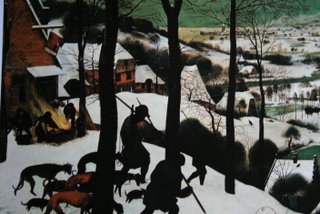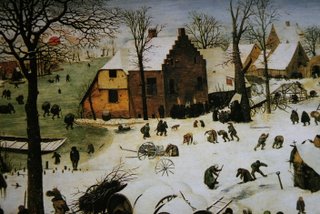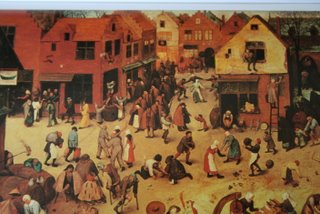Brueghel or Bruegel
Pieter Brueghel the Elder was a Netherlandish renaissance painter, often cited for his Hiermonyous Bosch-influenced "demonological" paintings. Brueghel was likely, however, the first Western painter to paint landscapes as an end in themselves, rather than as a backdrop to religious allegory. Brueghel was also a town-lover, among the earliest urban documentarians.
His Flemish village scenes are richly rendered, rife with non-idealized architecture, crofts and thatched houses rather than palaces or country estates, populated by argricultural workers, peasants, and tradespeople. The nameless and the everyday milieu.
 A detail from Hunters in Snow, featured memorably in Andrei Tarkovsky's severly haunting film Solaris (inexplicably re-made as a George Clooney vehicle). Probably Brueghel's first winter landscape. Blacksmiths toil as the huntsmen and hound return amidst fading light. The hillside is lined with houses of masonry construction, many with a jerkinhead, or clipped gable roof.
A detail from Hunters in Snow, featured memorably in Andrei Tarkovsky's severly haunting film Solaris (inexplicably re-made as a George Clooney vehicle). Probably Brueghel's first winter landscape. Blacksmiths toil as the huntsmen and hound return amidst fading light. The hillside is lined with houses of masonry construction, many with a jerkinhead, or clipped gable roof.
 The Numbering at Bethlehem was signed and dated 1566. Elsewhere in the picture, the Imperial tax gatherers have established themselves at an inn, to collect duties as pigs are slaughtered, children play, and the drama of the Nativity unfolds. (Brueghel was about 40 when the Duke of Alba led Spanish forces into Brussels to forcibly convert the Protestants). In the center, a two story structure with a stepgevel and a second-story sand colored addition commands attention. Seen through bare branches, the red, winter sun nears the horizon.
The Numbering at Bethlehem was signed and dated 1566. Elsewhere in the picture, the Imperial tax gatherers have established themselves at an inn, to collect duties as pigs are slaughtered, children play, and the drama of the Nativity unfolds. (Brueghel was about 40 when the Duke of Alba led Spanish forces into Brussels to forcibly convert the Protestants). In the center, a two story structure with a stepgevel and a second-story sand colored addition commands attention. Seen through bare branches, the red, winter sun nears the horizon.

Another particolare, this time from The Fight Between Carnival and Lent, and a town square setting. A typically busy scene, filled with a baker's wares, a window washer, and a meager cortege. Amongst the architectural detail: more stepgevels, and a half timbered house in the rear with an elaborately ornamented bargeboard. Tiny windows appear near the gable ridges, and shallow pent roofs, or shed roofs are evident above first floor windows.
His Flemish village scenes are richly rendered, rife with non-idealized architecture, crofts and thatched houses rather than palaces or country estates, populated by argricultural workers, peasants, and tradespeople. The nameless and the everyday milieu.
 A detail from Hunters in Snow, featured memorably in Andrei Tarkovsky's severly haunting film Solaris (inexplicably re-made as a George Clooney vehicle). Probably Brueghel's first winter landscape. Blacksmiths toil as the huntsmen and hound return amidst fading light. The hillside is lined with houses of masonry construction, many with a jerkinhead, or clipped gable roof.
A detail from Hunters in Snow, featured memorably in Andrei Tarkovsky's severly haunting film Solaris (inexplicably re-made as a George Clooney vehicle). Probably Brueghel's first winter landscape. Blacksmiths toil as the huntsmen and hound return amidst fading light. The hillside is lined with houses of masonry construction, many with a jerkinhead, or clipped gable roof. The Numbering at Bethlehem was signed and dated 1566. Elsewhere in the picture, the Imperial tax gatherers have established themselves at an inn, to collect duties as pigs are slaughtered, children play, and the drama of the Nativity unfolds. (Brueghel was about 40 when the Duke of Alba led Spanish forces into Brussels to forcibly convert the Protestants). In the center, a two story structure with a stepgevel and a second-story sand colored addition commands attention. Seen through bare branches, the red, winter sun nears the horizon.
The Numbering at Bethlehem was signed and dated 1566. Elsewhere in the picture, the Imperial tax gatherers have established themselves at an inn, to collect duties as pigs are slaughtered, children play, and the drama of the Nativity unfolds. (Brueghel was about 40 when the Duke of Alba led Spanish forces into Brussels to forcibly convert the Protestants). In the center, a two story structure with a stepgevel and a second-story sand colored addition commands attention. Seen through bare branches, the red, winter sun nears the horizon.
Another particolare, this time from The Fight Between Carnival and Lent, and a town square setting. A typically busy scene, filled with a baker's wares, a window washer, and a meager cortege. Amongst the architectural detail: more stepgevels, and a half timbered house in the rear with an elaborately ornamented bargeboard. Tiny windows appear near the gable ridges, and shallow pent roofs, or shed roofs are evident above first floor windows.
Labels: Highbrow

<< Home